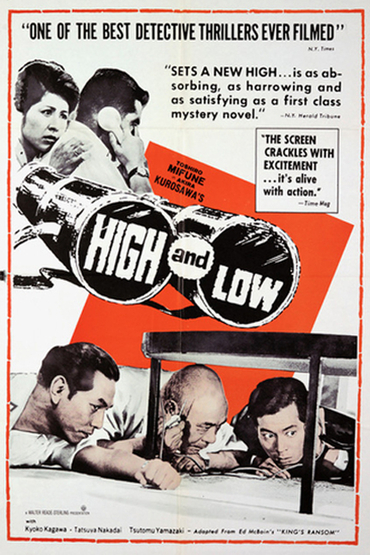George Lucas has one of those faces I just want to punch. (His hair bugs me, too.)
Would I feel the same way if he weren't the father of the ever-metastasizing Star Wars franchise, with its rickety mythology, shallow philosophy and, from what I hear, ever-diminishing creative returns?
I tamp down this irrational hostility by remembering the two good things that came out of Star Wars: Harrison Ford, and Lucas' repeated acknowledgement that his film was inspired by Akira Kurosawa's samurai saga, The Hidden Fortress (1958).
Of course, many directors have "borrowed" from the Japanese master: The Seven Samurai was remade as The Magnificent Seven, and Yojimbo became A Fistful of Dollars (and then a lawsuit.) But given the intense nature of fandom, Lucas' imprimatur has doubtless led who knows how many movie geeks to explore Kurosawa's astonishing catalog.
And maybe, if and when they matured, they took a chance on one of his "modern dress" films, like High and Low.
Japan, 1963. Kingo Gondo (Toshiro Mifune), a director with National Shoes, has just set in motion a secret plan to buy a controlling interest in the company — going into crippling debt to do so — when the phone rings.
His son has been kidnapped.
Of course he'll pay the huge ransom. It will ruin him, especially right now, but he has no choice.
Gondo hangs up the phone — and his son enters the room, looking for his playmate, the chauffeur's son.
The kidnapper has abducted the wrong boy.
In any other film, the moral dilemma — to pay, or not to pay — would take up most of the movie, but High and Low is just getting going.
The opening scene, set right before the kidnapping, is like a shot from a starting pistol: Kurosawa somehow infuses an Executive Suite-type scene of five men arguing about the quality of women's shoes with tension and menace.
Mifune is all coiled, barely contained rage as Gondo, but look past his gruff, granite exterior: He's the only executive at National Shoes who still cares about craftsmanship, quality and his own integrity while his colleagues want to slash costs in the interests of profits, hence his motive for the takeover scheme.
(The same sense of duty eventually prompts him pay the 30 million yen ransom for his chauffeur's son after all, making Gondo one of the few noble wealthy capitalists portrayed on film.)
The first half of High and Low is a chamber piece: Characters assemble in Gondo's living room (notably huge by Japanese standards) as he wrestles with his dilemma.
Kurosawa's subtly ingenious blocking illustrates each character's ever changing status and attitudes, as actors quietly shift positions in a choreographed constellation that's been compared to ikebana, the Japanese art of flower arranging.
After an hour's running time, High and Low transforms into another movie altogether: as soon as Gondo agrees (against the kidnapper's instructions) to involve law enforcement, the film cracks open beyond Gondo's well-appointed hilltop home onto the sordid city streets below, and into the crowded, stiflingly hot police precinct.
If you love police procedurals and haven't watched High and Low, you're missing out. Reminiscent of old fashioned classics like The Naked City and T-Men, but without the ponderous narration, the investigation into the kidnapping is a thrill to watch.
(Serious question: Have police ever been this competent and imaginative in real life, or are they only like that in the movies?)
Of course, highbrow critics can't just enjoy watching a taut Hitchcockian thriller — they have to justify their pleasure by praising High and Low as "social commentary," like this guy:
"High and Low isn't just a police procedural thriller; it is an indictment of capitalistic excess, of the supposed moralistic bankruptcy of post-War Japan that so many Japanese filmmakers feared, and of the people at the top of the world, content to let the masses below churn and break apart against the rocks."
Yes, I know the movie is called High and Low (although the more accurate translation from the Japanese would be the more ambiguous Heaven and Hell) so we're meant to give some thought to the contrast between Gondo's wealth and the kidnapper's destitution. But surely Kurosawa's primary motivation wasn't merely to echo the tepid truism that, well, some people are rich, and some people are poor. These critics are projecting their own pedestrian world views upon a genius. It's clear to any unbiased viewer that Kurosawa isn't pushing "social justice" but presenting life as it is, a realm of corruption, heroism, brilliance, stupidity, and swift, cruel reversals of fortune.
And doing so with extraordinary artistry.
For a more worthwhile appreciation of High and Low, I recommend this documentary about the making of the film, focussing on Kurosawa's stringent craftsmanship and attention to detail.
You may come away like I did, astonished that this (or, frankly, any other movie) ever gets made at all. Including, alas, Star Wars.
Let Kathy know what you think of this column by logging into SteynOnline and sharing below. Commenting privileges are among myriad perks reserved exclusively for members of The Mark Steyn Club, alongside exclusive invitations to Steyn events and access to the entire SteynOnline back catalog. Kick back with your fellow Club members in person aboard one of our annual cruises. We've rescheduled our Mediterranean voyage to next year, but it's sure to be a blast with Michele Bachmann, Tal Bachman, John O'Sullivan and Douglas Murray among Mark's special guests.

